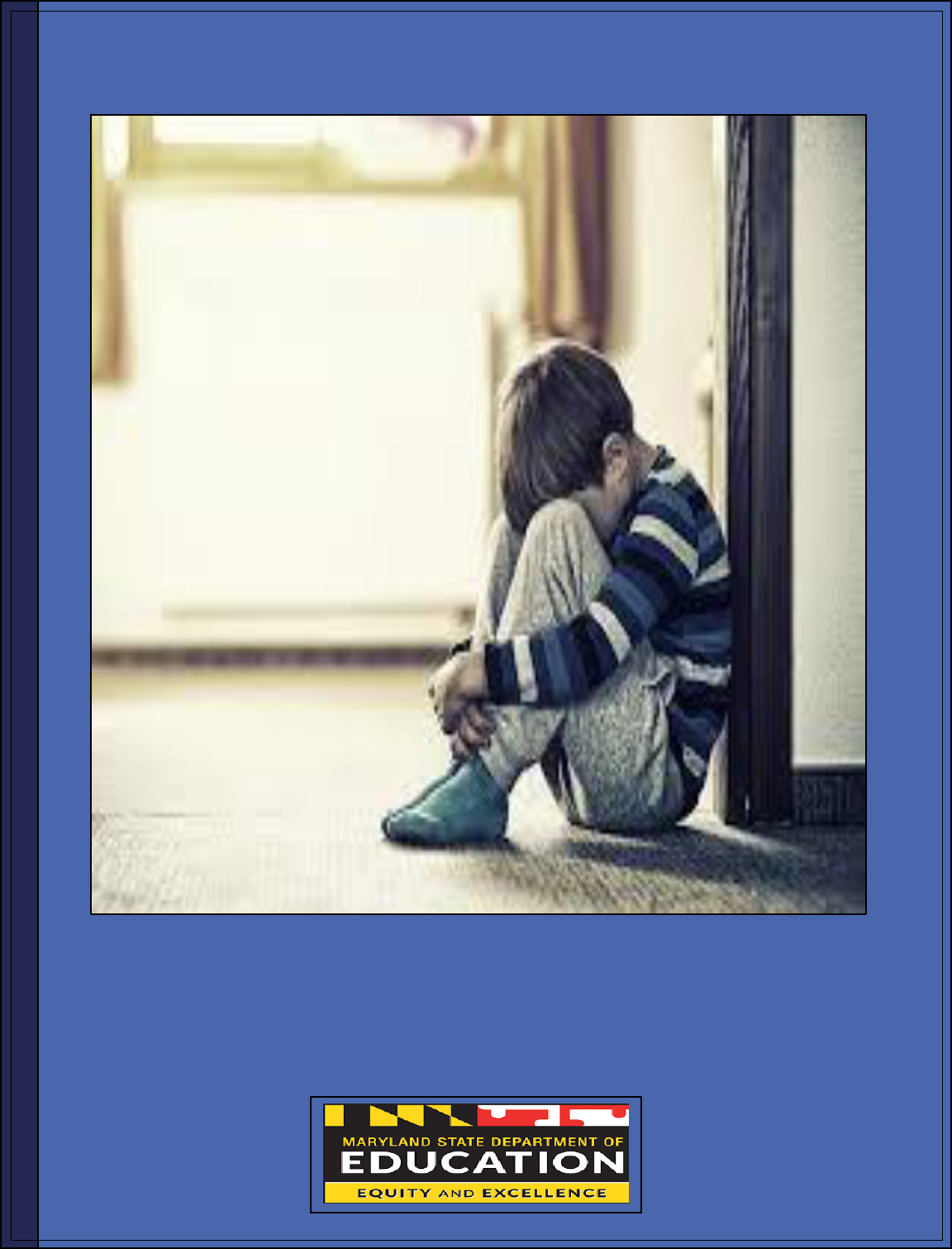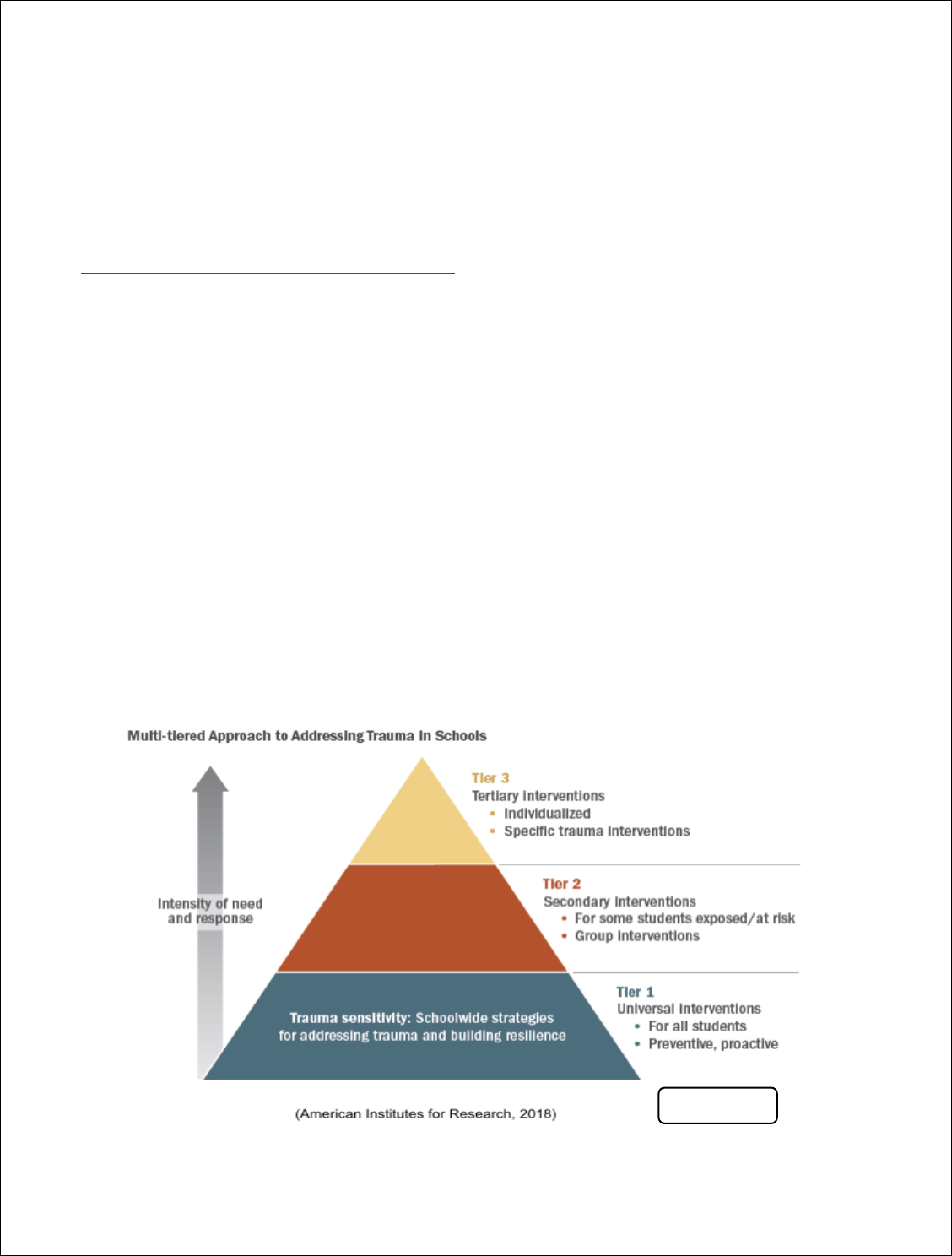
A T R A U M A - I N F O R M E D A P P R O A C H
F O R M A R Y L A N D S C H O O L S
The Maryland State Department of Education
MARCH 2021
200 WEST BALTIMORE STREET BALTIMORE, MARYLAND 21201

1
Karen B. Salmon, Ph.D.
State Superintendent of Schools
Clarence C. Crawford
President, Maryland State Board of Education
Larry Hogan
Governor
Sylvia A. Lawson, Ph.D.
Chief Performance Officer
Office of the Deputy for School Effectiveness
Mary L. Gable
Assistant State Superintendent of Schools
Division of Student Support, Academic Enrichment, and Educational Policy
Walter J. Sallee, MPA
Director, Student Services & Strategic Planning
Division of Student Support, Academic Enrichment, and Educational Policy
Kimberly A. Buckheit
Section Chief, School Safety & Climate
Division of Student Support, Academic Enrichment, and Educational Policy
Marone L. Brown, Ph.D.
Lead Specialist for School Safety, Project Director, Grants to States for School Emergency
Management (GSEM)
Division of Student Support, Academic Enrichment, and Educational Policy
Terrell L. Sample, MPA, MSOL
Education Specialist, Project Director, Bureau of Justice Assistance (BJA) and
MD-Project AWARE
Division of Student Support, Academic Enrichment, and Educational Policy
The Maryland State Department of Education does not discriminate on the basis of age, ancestry/national origin,
color, disability, gender identity/expression, marital status, race, religion, sex, or sexual orientation in matters
affecting employment or in providing access to programs and activities and provides equal access to the Boy Scouts
and other designated youth groups.
For inquiries related to Department policy, please contact:
Equity Assurance and Compliance Office
Office of the Deputy State Superintendent for Finance and Administration
Maryland State Department of Education
200 W. Baltimore Street – 6
th
Floor
Baltimore, Maryland 21201-2595
410-767-0426 – voice
410-767- 0431 – fax
410-333-6442 – TTY/TDD

2
CONTRIBUTORS
Marone L. Brown, Ph.D.
Lead Specialist for School Safety, Maryland State Department of Education
Heather Chapman, LCSW-C
Vice President, Neighborhood Zones United Way of Central Maryland
Kari Gorkos
Sr. Director, Public Education and Programs, Mental Health Association of Maryland
Kelly Gorman
Handle with Care Coordinator, Maryland Governor’s Office Crime Control and Prevention
Courtnay Hatcher, Ed.S., NCSP, BCBA
School Psychologist, Frederick County Public Schools
Sharon Hoover, Ph.D.
Director, Center for School Mental Health
University of Maryland School of Medicine
Tim Morrow
School Principal, Antietam Academy
Kimberly A. Muniz, M.A. /CAS, NCSP
Supervisor of Student Services Behavioral and Mental Health, Carroll County Public Schools
Kelly Parsons, Psy.D.
Clinical Psychologist, Maryland Department of Health
David Rose, MD, MBA
Chief Medical Director, Maryland Department of Human Services
Terrell L. Sample, MPA, MSOL
Director, Bureau of Justice Assistance (BJA) and MD-AWARE, Maryland State Department of
Education
Joan B. Smith, MSW, LCSW
Chair, Eastern Shore School Mental Health Coalition
D’Lisa Worthy, M.Ed.
Chief, Early Childhood Services, Maryland Department of Health

3
Contents
CONTRIBUTORS ........................................................................................................................................ 2
EXECUTIVE SUMMARY .......................................................................................................................... 4
INTRODUCTION ........................................................................................................................................ 5
Trauma-Informed Schools .......................................................................................................... 7
The Logic Model .................................................................................................................................... 7
Creating Safe Spaces and Staff Well-Being ................................................................................. 8
Creating Safe Spaces ............................................................................................................................. 8
Staff Well-Being .................................................................................................................................. 10
Empowerment: Voice and Choice ............................................................................................ 11
Equity and Resilience ................................................................................................................ 11
Equity .................................................................................................................................................. 11
Resilience ............................................................................................................................................ 12
Positive Relationships ............................................................................................................... 13
Family and Community Engagement ........................................................................................ 14
CONCLUSION ........................................................................................................................................... 17
GLOSSARY ............................................................................................................................................... 18
REFERENCES ........................................................................................................................................... 20
RESOURCES ............................................................................................................................................. 22

4
EXECUTIVE SUMMARY
Pursuant to MD Education Article §7-427.1 Trauma-Informed Approach, the Maryland State
Department of Education (MSDE) is required to expand the use of trauma informed approaches
in schools and intensively train schools on becoming trauma informed.
The Trauma-Informed Approach Guidance was developed to provide a framework to Local
School Systems (LSSs) in establishing a holistic approach to education in which all teachers,
school administrators, staff, students, families, and community members recognize and
effectively respond to the behavioral, emotional, relational, and academic impact of stress on
those within the school system. The purpose of this guide is to assist LSSs in implementing
trauma-informed approaches through a multi-tiered system of support.
Research has long supported the critical roles that schools can and do play in supporting
development beyond academic instruction. Schools most often provide a safe haven where
children build relationships with trusted adults who contribute to their healthy development. At
the same time, the demands and expectations of school can be especially challenging for students
who experience traumatic stress, and factors such as negative school climate and poor teacher-
student relationships can make school a place that worsens symptoms of trauma or even re-
traumatizes an individual.
In June 2020, MSDE established a trauma-informed approach work group to accomplish the
tasks outlined in the aforementioned legislation. The work group consisted of representative
from varying agencies across Maryland, including but not limited to, the Maryland Department
of Health, and the Maryland Department of Human Services with a range of expertise in the
areas of trauma, trauma-informed practices, adverse childhood experiences (ACEs), multi-tiered
systems of support, resilience, and childhood development. The goal of the workgroup was to
establish a shared vision and definition for a trauma-informed approach for LSSs in Maryland.
The work group would also create guidelines for trauma-informed approaches to assist school
systems with:
(a) Implementing a comprehensive trauma-informed policy at school;
(b) The identification of a student, teacher, or staff member who has experienced trauma;
(c) For schools participating with the “Handle with Care” program the appropriate manner for
responding to a student who is identified as a “Handle with Care” student; and
(d) Becoming a Trauma-Informed School that promotes healing.
For guidance questions and/or assistance, please contact:
Marone L. Brown
Division of Student Support, Educational Policy and Academic Enrichment
Email: [email protected] Phone: (410) 767-0481
Terrell L. Sample
Division of Student Support, Educational Policy and Academic Enrichment
Email: [email protected] Phone: (410) 767-0305

5
INTRODUCTION
Adversity and trauma have a significant impact on the learning and lives of individuals. During
the last decade, there has been an increase in public awareness of the impact of trauma on the
lives of individuals. Addressing trauma early in life through trauma-informed approaches can
improve outcomes for individuals. MD Education Article §7-427.1) directed the MSDE to
develop guidance in support of schools implementing a trauma-informed approach. Trauma
affects a person’s quality of life across all domains (behavioral, emotional, and psychological).
In the United States, 90 percent of students attend public schools where most remain for 13
crucial years of development. Public schools are the ideal place to mitigate the impact of
childhood trauma by creating a healthy school ecosystem that addresses the needs of the whole
child.
Adverse childhood experiences refer to a set of experiences a young person may go through,
such as parental substance abuse or incarceration, divorce, or exposure to violence. The concept
of ACEs has broadened to include other social influencers of physical and mental health such as
housing and food insecurity and poverty. A large body of research indicates that the more ACE’s
a child goes through, the more likely they are to suffer negative or damaging health and
academic outcomes. Some ACE’s constitute traumatic events that can lead young people to
experience post-traumatic stress. According to research, before the age of four, approximately 26
percent of students experience trauma with almost 80 percent of the trauma occurring in the
home by their parents. Traumatic stress is multi-generational. Parents and caretakers who
experienced trauma as children and especially those whose trauma has gone unaddressed are at
risk of repeating a cycle within their own families. The forthcoming strategies and approaches
outlined within this guidance document are designed to ensure that students have the support
needed to graduate and live productive lives through the implementation of trauma-informed
approaches that impact all individuals, students, caregivers, and school staff.
Being trauma-informed is not enough, being trauma-responsive is the goal. Children are exposed
to different degrees of trauma and have their own unique set of circumstances that can protect
them against that trauma. The other half of the equation is resiliency. Resiliency is defined as the
ability to overcome and be successful despite exposure to risk. Some children need protective
factors strengthened to help buffer against risk. As such, there is a current shift to trauma-
responsive education in classrooms and schools across the country. Being trauma-responsive
requires the integration of trauma-informed principles into staff behaviors and practices that
improves their interactions with all students. Additionally, this includes mental health support
provided by school psychologists, school counselors, and other school employed staff, as well as
community partners who provide trauma specific supports and treatment.
Research shows that responding to trauma early increases the likelihood of success as behaviors
due to trauma histories intensify as students get older, including the use of alcohol, drugs, and
other risky behaviors. The trauma-responsive approach is inclusive of a strength-based approach
that promotes healing. Interventions focus not just on “what happened to you” as an individual,
but also “what is right with you” and capitalizes upon individuals’ strengths.

6
Interventions must focus on the systematic factors (e.g., racism, poverty) that contribute to
adversity and trauma, and on the collective impacts of adversity and trauma on communities.
Strengths-based and healing-centered approaches can leverage community assets, including the
cultural and social factors that strengthen individual and community identities and connections.
This is sometimes referred to as the “fix injustices, not kids” principle.
Individuals embracing a growth mindset setting high expectations focused on achievement,
despite existing and prior circumstances, will advance efforts toward equitable opportunities and
positive lifestyle outcomes. The shift in mindset from one of “learned helplessness to learned
optimism” pertains to ALL, not just those subjected to trauma. At the same time, approaches to
address trauma must consider system factors (and not just individual factors) that contribute to
the negative impacts of trauma. It is not enough to ask our children to adopt a “growth mindset”
or to establish greater social emotional competencies if they are not simultaneously supported by
system interventions that reduce or eliminate toxic and stressful environmental factors that lead
to adversity and trauma.
The MSDE recognizes that building and maintaining trauma-informed approaches in schools
requires systems to first build an awareness of trauma among stakeholders, then design, support
and engage stakeholders in the implementation of practices that are trauma-responsive. The
trauma-informed work must include the supporting of adults who serve these students ensuring
self-care to prevent and mitigate proximal trauma (i.e., secondary trauma) and compassion
fatigue.
A trauma-informed approach will interrupt the school to prison pipeline and disparate
disciplinary practices of marginalized students. Research has established that the use of a trauma-
informed approach in schools increases equitable student engagement and creates protective
factors which support graduation and future employment. This guide will provide common
language understanding of trauma to help schools successfully implement trauma-informed
approaches. The forthcoming information leverages the expertise and practices from local and
national experts to advance the essential components of implementing a trauma-informed
approach in schools.

7
Trauma-Informed Schools
Trauma-informed approaches cannot depend on the vision of a single individual but must be
institutionalized or embedded within the fabric of a system. Studies have shown that complex
trauma greatly affects behavior, academic performance, and dropout rates in schools. As such, it
is important to make trauma-informed practices the norm, not the exception. Democratizing
trauma-informed schools (making it available to all) will provide individuals with trauma a more
adequate level of support to educational opportunities that:
• Realize both the widespread impact of trauma and the role of schools in promoting
resiliency.
• Recognize the signs and symptoms of trauma in students, staff, and families.
• Respond by fully integrating knowledge about trauma into policies, procedures, and
practices.
• Resist re-traumatization of students and staff and fosters resiliency.
The Logic Model
A trauma-sensitive school can expect an increase in retention, decrease in suspension, expulsion,
dropout rates, arrests, and disparate disciplinary practices. As students develop a feeling of safety
in their school environment and school personnel build trust, students with trauma history will be
able to get their needs met in appropriate ways. This document is not meant to present an
exhaustive list, as the trauma-informed research continues to emerge, but to instead provide
some guidance on how schools can utilize trauma-informed approaches to change social,
emotional, and academic outcomes for students.
The Logic Model provides local school systems with a comprehensive framework for the
establishment of a healthy school ecosystem. There are five core components of trauma-
informed schools that must be included in every model: (1) training faculty and staff on the
impact of trauma, (2) adopting a school wide perspective shift, (3) creating healing relationships
among staff, caregivers, and students, (4) maximizing caregiver capacity, and (5) facilitating
student empowerment and resiliency https://traumainformedoregon.org/.

8
The core of this guidance document is outfitted into five key domains that align within the
framework of the Trauma-Informed Care Logic Model. The domains are as follows: (1) Creating
Safe Spaces and Staff Well-being, (2) Empowerment: Voice, and Choice, (3) Equity and
Resilience (4) Positive Relationships and (5) Parent and Community Engagement.
Creating Safe Spaces and Staff Well-Being
Advancements in neurology provide educators with important information related to optimal
conditions for learning. Safety is a basic human need, second only to food, water and shelter and
is a fundamental condition for the acquisition of knowledge. For LSSs, creating safe spaces is a
complex, multi-faceted issue that requires specific attention to several factors. Safety involves
not only the physical environment, but also emotional and psychological well-being, which are
critical aspects of feeling safe. Safety is particularly important for individuals experiencing
trauma because of violence, trauma, daily challenges in meeting basic needs, strained
relationships, and the high prevalence of behavioral health disorders. Safety is critical for
students and staff experiencing trauma. As such, creating a safe environment in which to learn
requires acknowledging the interaction of the person(s) and their environment. The focus should
be on developing nurturing environments that cultivate respect among individuals and minimize
conditions such as loud and crowded spaces, overly bright or dim lighting, bullying and other
harmful behaviors.
Creating Safe Spaces
A “safe space” is not just a physical location. It can also be something as simple as a group of
people who hold similar values and commit to consistently provide each other with a supportive,
respectful environment. Trauma most often changes the way children and young people view
their world, the people in it, and how and where they belong. They can develop distorted rules
about relationships – rules built from mistrust, terror and betrayal. Safe spaces can provide a
break from judgement, void of unsolicited opinions, and allow for freedom to detach from their
inauthentic selves. Safe spaces allow people to feel supported as their authentic self. This is
Figure 1

9
especially important for minorities, members of the LGBTQ+ community, and other
marginalized groups.
Conversations about safety must be grounded in trauma-informed approaches that foster values
of dignity, equity, and compassion that set the tone for behaviors, policies, structures, and
environments. The acronym S.P.A.C.E. can be used to represents five key dimensions that when
incorporated into approaches offer significant potential to establish effective opportunities for
schools to anticipate and respond to the needs of traumatized individuals.
• Staged- Sophisticated functions of the brain-body only emerge after basic functions have
been developed and consolidated with rehearsal and practice. For example, skills like
reading increase in complexity through repetition and rehearsal, building on basic blocks
of letters, syllables, words, sentences, and paragraphs. Strategies aimed at resourcing
traumatized children need to follow this staged pattern of conceptualization and
implementation for them to succeed.
• Predictable- The brain-body systems of traumatized young children maintain itself in a
state of arousal readiness in preparation for the re-occurrence of a threat. Unpredictable
routines and reactions from others amplify the stress response used by traumatized
children and young people. The opposite is also true. Strategies, which promote stability
and familiarity, reduce the need for the stress system to be engaged. This releases the
energy that children and young people use to lock down their experiences and avoid
change. Safe spaces allow traumatized children and young people to experience
themselves as more flexible and more able to tolerate small degrees of change in the
environment.
• Adaptive- The intensity and challenging behavior of traumatized children and young
people can lead to unitary explanations being applied to their motivations and drives.
The options for traumatized children and young people can be increasingly focused on
discipline and behavior management. Punitive systems restrain flexibility. As such,
strategies which promote adaptability in children and young people are those which are
able to maintain multiple meanings for behavior and remain open to multiple options for
intervention.
• Connected- Traumatized children and young people develop insecure and unstable
templates for forming, maintaining, and being in relationships. In a school context where
relationships are constantly negotiated and renegotiated, traumatized children experience
social exchanges as sources of stress which maintain the need for trauma-based
behavioral routines. Relationships become the primary vehicle through which new
meanings about feelings, beliefs, behaviors, and identity are resourced to emerge.
Connected children and young people are calmer and more able to access their internal
systems to learn.
• Enabled- Traumatized children and young people find the process of understanding
themselves difficult. They are challenged in their capacity to identify their feelings,
understand them, and communicate them to others. Effective strategies for responding to
traumatized children in the school context will enable them to make linkages between
and give meaning to their experiences in their past and present, the feelings and their
behavior, their thoughts and their actions.

10
Staff Well-Being
Relationships are dyadic-it takes two. Adults most often recognize the student’s contribution to
these interactions, but less often is time taken to consider the teachers contribution to the dyad.
Frequently, educators do not have the knowledge, skill, or capacity to care for themselves and
the student with ACEs. This most often leads to undesirable interactions that exacerbate negative
outcomes. As such, it is important to offer trainings to all school staff, including cafeteria, and
janitorial staff on trauma and its impact on health and behavior. Because school support
personnel, including front desk reception area workers, security officers, and drivers often
interact with students, they play an important role in making students feel safe and welcome and
should be included in the awareness building events or trainings. In addition, trauma-informed
trainings can better help staff understand student behavior and thereby improve student staff
interactions.
Teacher temperament and emotionality daily and over time is a major contributor to the
classroom and school climate. The ever-expanding burden upon educators further complicates
the dynamic. Most educators are truly phenomenal, self-sacrificing individuals who greatly
extend themselves to meet the needs of their students and families. However, it is important to
note that school personnel are not exempt from traumatic stress and adverse childhood
experiences. Most all adults enter the workplace every day with personal baggage, existing or
historical which colors their perceptions and impacts interactions with others. For this reason, it
is important that educators be provided with, and encouraged to use tools that allow them to
engage in ongoing self-reflection and self-care to successfully meet the demands of their job and
to better equip themselves for the job.
All personnel have the power to direct major climate control in the school by committing to
being a thermostat. It is important to recognize that placing full onus on individual staff members
to support their well-being considering known effects of secondary trauma is not sufficient.
SAMSHA (2014) recommends that educational school leaders take action to promote
organizational, cultural, policies and practices to support staff. These include:
• Redesigning school and/or district wide policies around training and scheduling;
• Focus on prevention by being proactive in supporting stress management;
• Shifting to a reflective supervision model that relies upon a supportive teacher;
supervisor relationship moving away from adversarial models of supervision;
• Building and reinforcing school and/or district wide natural support systems for
local school system employees; and
• Evaluating school and/or district wide efforts in the aforementioned areas.
It is of equal importance for schools to be a safe space for staff to learn and grow both personally
and professionally. Expanding trauma-informed approaches developed and implemented for
students to include similar opportunities for staff is advantageous. An example of this type of
extension would be providing a mindfulness space and procedures for staff to use when the need
arises. This strategy has proven helpful in increasing staff morale and decreasing the use of
punitive student discipline measures.

11
Empowerment: Voice and Choice
A large part of establishing a trauma-informed culture within LSSs include creating engagement
opportunities for traumatized students to share their thoughts and experiences with policy
makers, administrators, teachers, and other school personnel. This approach can be effective in
uncovering the lived experiences of those who have encountered trauma through their sharing of
thoughts and experiences. Student empowerment is when students gain the authority and agency
to make decisions about their school experience and implement change through their ideas. The
incorporation of student voice and choice early in the planning and awareness-building process is
critical to soliciting ongoing student member feedback.
Empowerment entails acknowledging and using students’ strengths early in the treatment process
rather than overemphasizing diagnoses, weaknesses, or victim status. The empowerment process
can impact students in several ways, including promoting individual and social development,
demonstrating the importance of student rights, promoting youth connection, increasing
confidence, and enhancing decision-making skills. Interventions designed to improve school
climate and instructional methods should be guided by empowering youth strategies, culturally
relevant pedagogy, varied teaching methods, theory driven choices, and positive relationships
with well-trained professionals to ensure students are ready to learn. Using an empowerment
perspective to address problems within the school means:
• Creating opportunities for collaboration with students.
• Encouraging students to identify what problems exists.
• Including youth voice in creating solutions and taking action.
Equity and Resilience
To address trauma in all of its forms and manifestations it is necessary to look at high level
systemic reform, this approach is akin to a public health-oriented model that says, “if you shape
the environment so that ALL kids regardless of level of risk are treated in a way conducive to
mental health, healing, resilience, and well-being, you can do a better job at addressing trauma
for all students.” – Dr. Todd Herren Kohl. The MSDE is committed to this systemic change
through distribution of this guidance document and technical assistance efforts, while also
promoting equity, resilience, and the well-being of school personnel.
Equity
Trauma is an issue of equity; it impedes educational attainment on its own, and
disproportionately targets students of color, students with disabilities, those living in poverty,
LGBTQ+ students, and others who experience marginalization. Specific to race, policies aimed
at providing “color-blind” equitable outcomes for all students fail to enact compensatory
remedies for a long history of racial inequality and injustice. The vision of color blindness as a
means of eliminating racial discrimination is founded on a seemingly paradoxical notion that it is
noble to ignore race while simultaneously honoring diversity. Being trauma-responsive requires
integration of trauma-informed principles into staff behaviors, policies and practices, and
partnership with professionals who provide traumatic specific treatment.

12
As such, implementing transformation is difficult, especially if faced with significant resistance.
It is not however more difficult than navigating oppressive barriers, which many students,
families, and educators of marginalized groups endure. In consideration of this, it is important
for LSSs to consider the following “Basic Principles of Equity Literacy” that can help avoid
equity detours and maximize the impact of our equity efforts:
• Direct Confrontation Principle – The path of equity requires direct confrontations with
inequity- with interpersonal, institutional, cultural, and structural racism, and other forms
of oppression. “Equity” approaches that fail to directly identify and confront inequity
play a significant role in sustaining inequity.
• Equity Ideology Principle- Equity is more than a list of practical strategies. It is a lens
and an ideological commitment. There are no practical strategies that will help develop
equitable institutions if individuals are unwilling to deepen their understanding of equity
and inequity and reject ideologies that are not compatible with equity.
• Prioritization Principle – In order to achieve equity, the interest of students and families
whose interests historically have not been prioritized, must now be prioritized. Every
policy, practice, and program decision should be considered through the questions, “What
impact is this going to have on the most marginalized students and families?” “How are
we prioritizing their interests?”
• Redistribution Principle – Equity requires the redistribution of material, cultural, social
access, and opportunity. This is done by changing inequitable policies, eliminating
oppressive aspects of institutional culture, and examining how practices and programs
might advantage some students over others. If systems and individuals cannot explain
how equity initiatives redistribute access and opportunity, they should be reconsidered.
• Fix Injustice, Not Kids Principle – Educational outcome disparities are not the result of
deficiencies in marginalized communities’ cultures, mindsets, or grittiness, but rather of
inequities. Equity initiatives focus, not on “fixing” students and families who are
marginalized, but on transforming the conditions that marginalize students and families.
• One Size, Fits Few Principle – No individual identity group shares a single mindset,
value system, learning style, or communication style. Identity-specific equity frameworks
(like group level “learning styles”) almost always are based on simplicity and
stereotypes, not equity.
• Evidence-Informed Equity Principle – Equity approaches should be based on evidence
for what works rather than trendiness. “Evidence” can mean quantitative research, but it
can also mean the stories and experiences of people who are marginalized in your
institution.
Resilience
Schools have the capacity to promote resilience in children and young people. Resilience is the
ability to cope and thrive in the face of negative events, challenges, or adversity. Key attributes
of resilience in children and young people include social competence, a sense of agency or
responsibility, optimism, a sense of purpose or hope for the future, attachment to family, to
school and to learning, problem solving skills, effective coping style, pro-social values, a sense
of self-efficacy, and positive self-regard. Schools can enhance resilience through programs like
restorative practices, which build positive social norms and generate a sense of connectedness to
teachers, peers, and the academic goals of the school.

13
Trauma and adversity disrupt the development of healthy attachment bonds that children need to
fulfill their full potential. As such, there are three important factors associated with building
resilience among all children and teens: (1) A strong parent-child relationship, or a strong
relationship with a surrogate caregiver who serves as a mentor if a parent is unavailable, (2)
Good cognitive skills which are predictors of academic success and lead to pro-social behavior;
and (3) The ability to self-regulate emotions, attention, and disruptive behaviors.
Positive Relationships
Research has substantially proven the significant impact of even one positive relationship in a
child’s life. Positive relationships and support are directly related to establishing resiliency,
quicker recovery rates, and lower incidents of relapse. Participating in a reparative experience
can often reduce the negative symptoms of trauma as well as reduce the likelihood of a trauma to
occur again. It is crucial for students to have not only positive relationships with their peers, but
also with adults. Children and young people who have had traumatic experiences inflicted upon
them have a difficult time trusting adults.
In educational settings, where power and control are present, it becomes increasingly difficult
but imperative to establish positive relationships. When adults are transparent, consistent, and
trustworthy, these relationships show the student that the staff member is safe, someone they can
confide in, and someone to rely on. This is accomplished by way of Unconditional Positive
Regard, which requires administrators, teachers, and staff to value a student regardless of his or
her behaviors, affect, or presentation. Unconditional Positive Regard facilitates an environment
of where the individual feels valued regardless of their presenting behaviors, affect, or
cognitions; rather than looking to others for identity and approval, the individual is encouraged
to learn and listen to themselves. Some examples are as follows:
• Personal greetings- Provide each student with a personal greeting using their name and
positive statement each day. Research supports that personal greetings can increase
cooperative behavior in students.
• Praise in public, correct in private- Trauma responses are often exacerbated when a
student feels threatened. Students who are corrected in front of an audience of their peers
may react negatively. Trust is maintained and corrective feedback is more effective when
delivered privately.
• Get to know your students outside the classroom- Try to get to know students, their
families, and their lives outside of school. Getting to know students during times of
baseline as well as when experiencing joy, fear, and anger can help staff identify when
they are in crisis.
The human condition makes it likely relationships will be harmed through simple day to day
interactions, with students experiencing trauma this harm may be more frequent and more
intense. It is advantageous if schools have created as part of a whole school structure, methods
to repair harm to relationships. When the expectation across school environments, and ideally
across community environments, is that all individuals engage in the reparation process than
those with a history of discarding damaged relationships are more likely to comply with the

14
expectation. Those facilitating the reparation process with individuals experiencing trauma must
be mindful of scheduling the event at a time when emotions have diminished as much as
possible; preparing all members in advance of a meeting; reviewing and reinforcing procedures
of conduct before, during, and after the process; and ensuring the process remains safe and
productive for all members. The process of damage and repair to a valued relationship is a
valuable therapeutic experience for individuals experiencing trauma.
Family and Community Engagement
Countless students and educational staff encounter traumatic experiences each day either directly
or vicariously through interactions with others. The prevalence of trauma has increasingly
become recognized as a significant public health concern adversely impacting the communities
we serve. Direct and indirect traumatic experiences or events can have immediate and long-term
adverse effects on an individual’s social, emotional, and physical well-being. As trauma-
informed practices evolve within schools, school mental health providers, and school personnel
recognize the importance of establishing proactive vs. reactive approaches to assist students and
staff affected by trauma. Healthy relationships are the foundation for effectively responding to
students and staff experiencing trauma and can be achieved when individuals immerse
themselves in cultivating robust partnerships inclusive of families and communities.
The goal of a trauma-informed school system is to: (1) recognize and respond to trauma as it
affects students, staff, and families; (2) to act in partnership with individuals impacted; (3) to
make resources available; (4) to address student and staff trauma, and to strengthen resilience
through family and community engagement. Family and community engagement is the means
through which essential relationships can be built, and through which policies, best practices, and
organizational culture can be shifted to create a trauma-informed system.
Figure 2

15
Collaboration enables students, staff, and families to work together to respond to trauma as it
impacts the student and staff members. This can include practical matters as the individual
sharing information about trauma(s) that have affected them or their family, as well as providing
background on their strengths and deficits. Effective engagement assists individuals and families
in understanding the impact of trauma, especially on student behavior. This approach
acknowledges that healing occurs in collaborative, trusting relationships, and the significance of
sharing power to make decisions. Families intertwined with accessible and nurturing
communities are vital supports that can stimulate a sense of identity and belonging for students
and staff. In an effort to overcome trauma and actively build resilience and protective factors to
resist re-traumatization, families and school staff need to be transparent about their source(s) of
trauma and receptive to the available support offered by schools and community organizations
seeking to implement trauma-based services in their respective settings.
The nucleus of a trauma-informed approach is about connections and connectedness; thus, it
cannot be effectively delivered in seclusion but rather through the framework of a multi-tiered
system of supports (MTSS) (Figure 2) which focuses on the overall needs of individual students
in alignment with existing school practices. Interventions and supports found in MTSS assist in
relationship building and promoting a positive school climate which are significant factors in
fostering student achievement and affording students the opportunity to navigate through their
challenges. Defined tiers of intervention for academic and behavioral challenges, which may
differ from system to system, enable systems to address student needs individually or as a group.
In order to equalize power inequities, schools need to level the playing field by equipping staff
with trauma education, training and resources.

16
Trauma-informed strategies like Handle with Care in schools include educating all school staff
about trauma and its effects; supporting physical and emotional safety in relationships and in
the environment; taking a proactive stance to reducing trauma-related triggers within the
school environment and excluding potential re-traumatizing practices; making trauma-specific
clinical services accessible to students with more intensive needs and addressing the secondary
effects of trauma.
Activities surrounding parent and community engagement within trauma-informed schools
should occur universally within a multi-tiered system of support and increase in scale and
intensity to meet the needs of students and staff who have experienced varying levels of
trauma. Initiatives could lead to modifications or enhancements to school policies, best practices,
professional development, and support to connect students, families and staff to needed school-
based and community trauma-informed services building and fostering resilience.
Handle with Care provides the school or childcare agency with a “heads
up” when a child has been identified at the scene of a traumatic event.
It could be a meth lab explosion, a domestic violence situation, a
shooting in the neighborhood, witnessing a malicious wounding, a drug
raid at the home, etc. Police are trained to identify children at the
scene, find out where they go to school and send the school or agency a
confidential email or fax that simply says: “Handle Johnny with care.”
That’s it. No other details

17
CONCLUSION
Being “trauma-informed” is just as much about a “way of being” than “a way of doing”. A
trauma-informed care model is encouraged as a standard of care across not only health
professions but school settings, regardless of whether a given individual has reported or
experienced trauma and without requiring school staff to know whether a specific individual has
a trauma history. Effective implementation of trauma-informed approaches within systems,
schools and communities requires the participation of all adults and should be approached in a
way that provides information to all and defines clear expectations of conduct by all. Students of
all ages interact with multiple adults over the course of their day. Inconsistent implementation of
approaches by adults is counterproductive to the intended effort of a trauma-informed teaching
and learning environment.
Students must be given opportunities to nurture multiple strengths and assets. However, many of
the current trauma-informed approaches have failed to explicitly focus attention on identifying
and increasing student strengths. As such, existing trauma-informed approaches are not reaching
the full potential of healing that is possible within the school context because they focus only on
repairing negatives and have not given sufficient emphasis on growth building upon the strengths
of trauma-affected students. Cultural context and conceptualization of self, whether
individualistic or collectivist, shape how a person experiences, perceives, makes meaning of, and
eventually heals from trauma. Rather than operating from the assumption that individuals need
special treatment because they come from a given culture or social context, school staff should
consider that students’ culture may serve as a source of strength and a resource for healing.
Achieving a trauma-informed teaching and learning environment occurs over time through a
variety of intentional practices. The use of professional development events to provide
information and teach approaches is only the beginning and should not be considered an
adequate strategy to ensure adult use of trauma-informed approaches. Schools who successfully
make the shift to being trauma-informed invest time into continuous dialogue amongst all staff
through book studies, individual student planning meetings, and honest, courageous reflection
upon past and current events. It is the intent of this guidance document to provide systems and
schools information to inform their journey toward becoming trauma-informed environments
where all students succeed. MSDE seeks to collaborate with all stakeholders in making the
content of this document a reality in Maryland schools.

18
GLOSSARY
Acute trauma- Results from a single stressful or dangerous situation or event.
Adverse Childhood Experiences (ACE’s)- Adverse Childhood Experiences include emotional,
physical, or sexual abuse; emotional or physical neglect; domestic violence; parental substance
use; parental mental illness; parental separation or divorce; death of a parent; incarcerated
household member; poverty or community violence These experiences are linked to long term
health outcomes in a series of studies (Felitti et al, 1998).
Child Traumatic Stress- Child traumatic stress (CTS) refers to the intense fear and stress
response occurring when children are exposed to traumatic events, which overwhelm their ability
to cope with what they have experienced. Children who experience CTS may also be diagnosed
with PTSD, depression, anxiety, or behavioral disorders.
Chronic trauma- Results from repeated and prolonged exposure to highly stressful situations or
events. Examples of chronic trauma include bullying, child abuse, and domestic violence.
Complex trauma- Results from exposure to multiple traumatic events.
Culture- An integrated pattern of human behavior that includes thoughts, communications,
languages, practices, beliefs, value, customs, rituals, manners of interesting, roles, relationships
and expected behaviors of a racial, ethnic, religious, or social groups; the ability to transmit the
above to succeeding generations.
Cultural Awareness- Being cognizant, observant, and conscious of similarities and differences
among cultural groups.
Cultural Competence-The ability to interact effectively with people of different cultures, helps
to ensure the needs of all community members are addressed.
Equity- Giving individuals what they specifically need to achieve health, success and positive
well-being.
Resilience- Is the ability and process of being able to adapt well in the face of adversity.
Re-traumatization- Is a conscious or unconscious reminder of past trauma that results in re-
experiencing of the initial trauma or traumatic event.
Post-Traumatic Stress Disorder (PTSD) - Is a mental health condition that is triggered by a
terrifying event, either experiencing it or by witnessing it.
Stress- Stress is a feeling of emotional or physical tension. It can evolve from any event or
thought that makes a person feel angry, anxious, frustrated, or nervous.

19
The Logic Model- Logic models and theories of change can help trauma-informed initiatives
conceptualize and operationalize the work to help build the capacity for trauma-informed
approaches to occur.
Trauma- Trauma is an emotional response to a terrible event that can have long-term effects on
a person’s well-being.
Trauma-informed care- Recognizes the presence of trauma symptoms and acknowledges the
role trauma plays in an individual’s life.
Trauma-sensitive school- Is a school in which all students feel safe, welcomed, and supported.
A school where addressing trauma’s impact on learning occurs schoolwide.

20
REFERENCES
Cahill, H., Beadle, S., Forster, R., Smith, K., & Farrelly, A. (1970, January 01). Building
resilience in children and young people: A literature review for the Department of education and
early childhood Development (deecd). Retrieved February 28, 2021, from
https://findanexpert.unimelb.edu.au/scholarlywork/970213-building-resilience-in-children-and
young-people--a-literature-review-for-the-department-of-education-and-early-childhood
development-(deecd).
CDC. (2019). Adverse Childhood Experiences. Retrieved from
https://www.cdc.gov/violenceprevention/childabuseandneglect/acestudy/index.html.
Developing and - center for early childhood mental health ... (n.d.). Retrieved February 28, 2021,
from https://www.ecmhc.org/documents/CECMHC_AdministratorsToolkit.pdf
From trauma-aware to trauma-informed. (n.d.). Retrieved February 28, 2021, from
https://traumainformedde.org/wp-content/uploads/2020/05/Trauma-BluePrint.pdf
Gorski, P. (n.d.). Avoiding racial equity detours. Retrieved February 28, 2021, from
https://www.academia.edu/38727480/Avoiding_Racial_Equity_Detours
Gorski, P. (n.d.). Educational equity: Equity literacy framework. Retrieved November 19, 2020,
from https://www.equityliteracy.org/equity-literacy
Hollingworth, L. (n.d.). Complicated conversations: Exploring race and ideology in an
elementary classroom - Liz Hollingworth, 2009. Retrieved February 28, 2021, from
https://journals.sagepub.com/doi/10.1177/0042085907312496
J; M. (n.d.). What is equitable resilience? Retrieved January 28, 2021, from
https://pubmed.ncbi.nlm.nih.gov/30177865/
Journal of Juvenile Justice, 5(1), spring. (2016). www.journalofjuvjustice.org
Kerri Ullucci, D. (n.d.). Exposing color Blindness/Grounding Color Consciousness: Challenges
for teacher education - kerri ULLUCCI, Dan Battey, 2011. Retrieved February 28, 2021, from
https://journals.sagepub.com/doi/abs/10.1177/0042085911413150
Pbis. (n.d.). Retrieved February 28, 2021, from https://www.resa.net/teaching-learning/pbis
Pisapia, J. (1994, October 31). Developing resilient schools and Resilient Students. research brief
#19. Retrieved February 28, 2021, from https://eric.ed.gov/?id=ED411343
Plumb, J. L., Kersevich, S. E., & Bush, K. A. (2016, Spring). Trauma-sensitive schools: An
evidence-based approach. Retrieved November 25, 2020, from
http://www.communityschools.org/assets/1/AssetManager/TSS.pdf

21
SAMHSA's concept of trauma and guidance for a Trauma ... (n.d.). Retrieved February 28, 2021,
from https://ncsacw.samhsa.gov/userfiles/files/SAMHSA_Trauma.pdf
Trauma-informed practices for postsecondary education: A guide. (n.d.). Retrieved February 28,
2021, from https://educationnorthwest.org/sites/default/files/resources/trauma-informed
practices-postsecondary-508.pdf.
Temkin, D., Harper, K., Stratford, B., Sacks, V., Rodriguez, Y., & Bartlett, J. (2020, November
12). Moving policy toward a whole school, whole community, whole child approach to support
children who have experienced trauma. Retrieved February 28, 2021, from
https://onlinelibrary.wiley.com/doi/10.1111/josh.12957.
Trauma informed practice in schools - act group. (n.d.). Retrieved March 1, 2021, from
https://theactgroup.com.au/documents/makingspaceforlearning-traumainschools.pdf.
Using logic models grounded in theory of change to support ... (n.d.). Retrieved February 28,
2021, from https://aspe.hhs.gov/system/files/pdf/262051/trauma-informed-logic-models.pdf.
10 steps to create a Trauma-Informed School. (n.d.). Retrieved February 28, 2021, from
https://starr.org/wp-content/uploads/10-Steps-to-Create-a-Trauma-Informed-School
Whitepaper.pdf.

22
RESOURCES
The follow list is not intended to be inclusive of all resources on the topic of trauma, rather it is merely a sample of
the plethora of media, literature, and research tools available.
What is Trauma This video will give a basic understanding of Trauma Informed Care
Informed Care? https://www.youtube.com/watch?v=fWken5DsJcw
3:33
What is Trauma? This video will give you an understanding of the different types of trauma.
4:01 https://www.youtube.com/watch?v=6BdW6tAb-5M
(ACE’s) Take the Survey
Adverse
Childhood
Experiences
Empathy: https://www.youtube.com/watch?v=cDDWvj_q-o8
Cleveland Clinic
Trauma-Sensitive School Checklist
The National Child. The National Child Traumatic Stress Network
Traumatic Stress
Network (NCTS)
Ted Talk (Video) What Trauma Taught Me About Resilience
